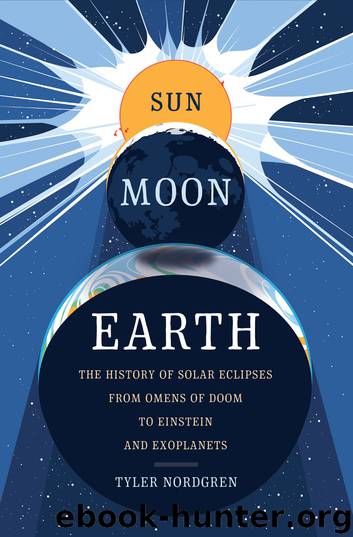Sun Moon Earth by Tyler Nordgren

Author:Tyler Nordgren
Language: eng
Format: epub
ISBN: 9780465096466
Publisher: Basic Books
Published: 2016-08-05T16:00:00+00:00
By this reasoning, since the famous astronomers of the nineteenth century were doing nothing more than filling in details of well-established laws, then perhaps it is no coincidence that today almost no one remembers their names. But the nineteenth century was also the greatest time of discovery for forces that had seemingly little to do with planets or gravity: electricity, magnetism, and optics. In 1865, while astronomers were busy looking for Vulcan, the Scottish physicist James Clerk Maxwell unified these phenomena into a set of four equations that revealed light to be a wave of changing electric and magnetic fields.a We tend not to think of electricity and magnetism outside of the electronics that power our daily lives, yet four of the five senses with which we perceive the world—taste, touch, sound, and smell—are just the interactions of atoms and molecules via their electric fields (while sight is the direct detection of light).
These laws are: (1) moving charges and changing electric fields create a magnetic field; (2) changing magnetic fields create currents and electric fields; (3) electric fields are caused by charges; and (4) there is no such thing as a magnetic monopole (all magnets come with two poles).
In 1895, at the age of sixteen, Albert Einstein thought very deeply about light and the ramifications of the laws that governed it. For instance, he wondered, what would a person see if he could ride a beam of light? A person on a beach sees waves crashing one after another on the shore, the water waving in and out. But a person surfing on a wave, traveling at its speed, rides a constant crest that no longer appears to “wave.” Maxwell’s equations provided no solution for this possibility with light. They required that for light to be “light,” it must move precisely at the speed of light. In fact, Michelson and other astronomers had verified this experimentally: no matter where you looked or how you moved, light always moved past you with the same speed.
It so happened that Maxwell’s equations had other problems with moving observers: charged particles in motion produced magnetic fields, while stationary ones did not. Depending on whether I am standing next to a proton or moving by one at a constant rate, I will see it produce different fields. This may not seem like a profound problem, but it puzzled Einstein and would eventually lead him to solve the mystery of Mercury—and in the process overturn how we understand the nature of time and space. The reason this is so puzzling is that the Relativity Principle, which has its origins in Galileo’s efforts to prove that the Earth can move without us feeling it, states that there is no experiment that can reveal whether a person is at rest or in constant, uniform motion. This principle must be true, since even when we are at rest in a laboratory, any experiment we do there is really flying at tremendous speeds as the Earth hurtles through space. Everything is always in motion relative to something.
Download
This site does not store any files on its server. We only index and link to content provided by other sites. Please contact the content providers to delete copyright contents if any and email us, we'll remove relevant links or contents immediately.
| Aeronautics & Astronautics | Astronomy |
| Astrophysics & Space Science | Comets, Meteors & Asteroids |
| Cosmology | Mars |
| Solar System | Star-Gazing |
| Telescopes | UFOs |
Tools of Titans by Timothy Ferriss(8297)
Turbulence by E. J. Noyes(7974)
Secrets of Antigravity Propulsion: Tesla, UFOs, and Classified Aerospace Technology by Ph.D. Paul A. Laviolette(5329)
Astrophysics for People in a Hurry by Neil DeGrasse Tyson(5149)
Room 212 by Kate Stewart(5063)
Design of Trajectory Optimization Approach for Space Maneuver Vehicle Skip Entry Problems by Runqi Chai & Al Savvaris & Antonios Tsourdos & Senchun Chai(5034)
Pale Blue Dot by Carl Sagan(4945)
The David Icke Guide to the Global Conspiracy (and how to end it) by David Icke(4651)
A Journey Through Divination and Astronomy by Publishing Pottermore(4362)
Goodbye Paradise(3758)
Apollo 8 by Jeffrey Kluger(3662)
COSMOS by Carl Sagan(3582)
Losing the Nobel Prize by Brian Keating(3514)
The Five People You Meet in Heaven by Mitch Albom(3513)
How to Read Water: Clues and Patterns from Puddles to the Sea (Natural Navigation) by Tristan Gooley(3428)
Brief Answers to the Big Questions by Stephen Hawking(3389)
How to Read Nature by Tristan Gooley(3287)
The Order of Time by Carlo Rovelli(3160)
A Brief History of Time by Stephen Hawking(2989)
